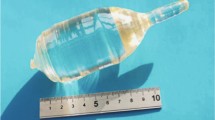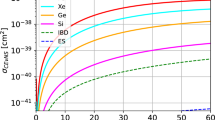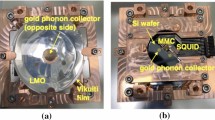Abstract
The experimental detection of the CE\(\nu\)NS allows the investigation of neutrinos and neutrino sources with all-flavor sensitivity. Given its large content in neutrons and stability, Pb is a very appealing choice as target element. The presence of the radioisotope \(^{210}\)Pb (T\(_{1/2}\sim\)22 yrs) makes natural Pb unsuitable for low-background, low-energy event searches. This limitation can be overcome employing Pb of archaeological origin, where several half-lives of \(^{210}\)Pb have gone by. We present results of a cryogenic measurement of a 15 g PbWO\(_4\) crystal, grown with archaeological Pb (older than \(\sim\)2000 yrs) that achieved a sub-keV nuclear recoil detection threshold. A ton-scale experiment employing such material, with a detection threshold for nuclear recoils of just 1 keV would probe the entire Milky Way for SuperNovae, with equal sensitivity for all neutrino flavors, allowing the study of the core of such exceptional events.
Similar content being viewed by others
Avoid common mistakes on your manuscript.
1 Introduction
Core-collapse supernovae (CC-SNe) are one of the most powerful phenomena occurring in our Universe. These dramatic transients may mark the death of stars heavier than \(8\ M_\odot\) and result in the formation of neutron stars or black holes [1]. SNe is a unique laboratory to investigate the properties of particles and matter under extreme conditions, the formation of chemical elements, and the birth of new stars. The understanding of the physics driving the Core-Collapse is therefore of great interest for particle physics and astrophysics [2]. The role of neutrinos in driving these events is of particular importance as they are key to trigger the process and are messengers of the nuclear reactions that take place during the explosion.
The recent discovery of coherent elastic neutrino-nucleus scattering [3] (CE\(\nu\)NS) offers a new intriguing detection channel for SNe neutrinos. Driven by a Z-boson exchange, CE\(\nu\)NS is a neutral current process and, as such, offers equal sensitivity to all neutrino flavors. It is a low-energy scattering where an impinging neutrino with energy of O(10MeV) transfers O(1keV) momentum to the recoiling nucleus [4]. The appeal of this process as detection channel comes from the fact that at such low energy, the momentum transfer is of the same order of the de Broglie wavelength of the target nucleus and, therefore, the cross-section gets coherently enhanced. This coherence enhancement scales with the number of neutrons squared and, in Pb, results in a cross-section that is 3 orders of magnitude larger than the one of Inverse Beta Decay (IBD) and 4 with respect to the one of Electron Scattering (ES), allowing relatively small detectors to assess SNe emission properties with the same precision as one of the gigantic neutrino telescopes provided that they achieve a detection threshold capable of assessing these low energy recoils [5].
2 Detection of SNe Neutrinos
2.1 The Coherent Neutrino-Nucleus Scattering
The cross-section for CE\(\nu\)NS can be derived within the Standard Model and it reads:
\(G_F\) is the Fermi coupling constant, \(\theta _W\) the Weinberg angle, Z and N the atomic and neutron numbers of the target nucleus, \(m_N\) its mass, E the energy of the incoming neutrino and \(E_R\) the recoil energy of the target. The term F(q) represents the distribution of the weak charge within the nucleus at momentum transfer \(q=\sqrt{2E_R m_N}\). From Eq. (1) we observe that large N and \(m_N\) favor the scattering. Heavy elements, such as Pb, are therefore the most interesting ones to be used as target.
The average recoil energy \(E_R\) can be derived from Eq. (1):
We can estimate the average recoiling energy knowing that SNe neutrinos have energies O(10MeV), so that \(E_R\sim 1\)keV.
The detection of O(1 keV) nuclear recoils is an experimental challenge that has been tackled by direct dark matter searches in the last decades. Low-background cryogenic particle detectors are the most promising technology due to their excellent energy resolution, better than 100eV for a detector of mass 300g [6].
2.2 Cryogenic Detection of SNe Neutrinos
In the following, we investigate scintillating PbWO\(_4\) crystals as target for SNe neutrinos because of the presence of Pb that leverages the coherent enhancement of the CE\(\nu\)NS cross-section and a crystalline form that offers good performance in operation as a cryogenic detector. In addition, the elevated density of the material allows for a relatively smaller detector when compared to other viable targets.
The total number of events induced in a detector with energy detection threshold \(E_{th}\) and number of target nuclei \(N_T\) can be written as:
where \(f_i(E,t)\) is the neutrino flux on Earth for the ith flavor at the time t. For a CC-SN of \(27\ M_\odot\) occurring at 10 kpc from Earth \(N_{exp}\) is 16.4 events per ton of PbWO\(_4\). A target of 1.7 ton of such material would have the capability to probe the entire Milky Way for SNe of that type [7].
The radioisotope \(^{210}\)Pb naturally present in Pb has an activity of several Bq/kg, making the usage of natural Pb not suitable for the purpose of SNe neutrino detection. In order to overcome this issue, we study the employment of Pb of archaeological origin as target material, where several \(T_{1/2}\) of \(^{210}\)Pb have gone by and the residual activity of this dangerous background is \(\le\)715 \(\mu\)Bq/kg, resulting in a count rate of 0.1 counts/keV/ton/10s for recoil energies in the range 1–30 keV [5]. We adopt this measuring unit for the detector exposure because neutrino signals develop during the time scale of few seconds (about 10 s), and the required detectors should have masses of the order of few tons (e.g. the RES-NOVA detector mass will be 1.7 tons).
The operation of a PbWO\(_4\) crystal as scintillating cryogenic particle detector offers the possibility of further background suppression by the simultaneous measurement of scintillation light and deposited energy [8]. The utilization of Transition Edge Sensors (TES) guarantees elevated sensitivity.
3 Operation of an Archaeological-Pb Containing PbWO\(_4\) Crystal with a Transition Edge Sensor
3.1 Experimental Set-up
A scintillating PbWO\(_4\) crystal grown utilizing Pb of archaeological origin of mass 15.7 g has been equipped with a W Transition Edge Sensor (TES) of the type utilized to instrument the light detectors of the CRESST experiment [9]. The deposition of the W-film was done by magnetron sputtering [10]. No dedicated sensor design optimization was performed. However a transition temperature of 19 mK was obtained on the W-film, a value that matches the requirements for operating the crystal as cryogenic particle detector. The crystal was produced by double crystallization from deeply purified archaeological lead and high purity tungsten oxide by Czochralski method at the Institute for Scintillation Materials of NASU (Ukraine).
The crystal is supported by a copper holder but not directly in contact with it. It is pressed against four sapphire balls with a metallic clamp so that the contact surface of the crystal with the thermal bath is minimized. On the surface of the holder facing the crystal a \(^{55}\)Fe radioactive source was glued. The rate of the source was about 50 mHz.
The detector was operated for 70 hours in a dilution refrigerator at Max-Planck-Institut für Physik in Munich (see Fig. 1).
During operation, the TES was biased with a constant DC current of 1\(\mu\)A and read-out by a DC-squid. The squid output was DC coupled to a 16-bit ADC and written to disk by means of a hardware trigger DAQ. During the whole operation of the detector, the TES operating point was constantly monitored and the detector’s temperature adjusted accordingly so that the TES response was kept as constant as possible during the measurement.
Pulses resulting from particle interactions as well as randomly sampled empty baselines have been acquired. The latter is used to determine the noise power spectrum, a key ingredient for the Optimum Filter in the later analysis.
(Color Figure Online) Picture of the detector (Left) and schematics of the experimental set-up (Right). The detector is supported by a block of copper that provides the thermal coupling to the cryostat. The crystal is pressed against four small sapphire balls to reduce the surface contact with the copper holder. The TES is weakly coupled to the copper holder via thin gold wire with length of 1 cm. The TES ohmic contacts and bond wires are made of Al. In between the crystal and the copper holder a \(^{55}\)Fe radioactive source is present
3.2 Energy Calibration
The TES response to particle interactions was characterized by averaging a set of pulses recorded from the detector. The range of selected amplitudes for the estimation of the average pulse was such that they were in the linear response range of the sensor. In addition, stability and quality cuts were applied to reject pile-up event, artifacts and unstable periods. The resulting average pulse represents the detector’s response in the linear region, free of read-out noise (Fig. 2Left). The amplitude of each pulse is determined by fitting the average pulse to its waveform and exploiting the thermal model of [?] for the energy scaling of the average pulse.
In the amplitude spectrum, the K\(_\alpha\) line of the \(^{55}\)Mn is identified and its nominal value (5.9 keV) used to calibrate the events (Fig. 2Right). The nonlinearity of the detector at such high-energies does not allow to resolve the K\(_\alpha\) and K\(_\beta\) (at 6.5 keV) emissions of the source.
(Color Figure Online) (Left) Average pulse in operating point obtained from a list of selected pulses in the linear region of the sensor. Due to the elevated count rate during the measurement, the average pulse shows a tilted baseline, indicating that the baseline is not flat on the time-scale of a pulse. (Right) Calibrated energy spectrum recorded over a raw time of 70 hours. The prominent peak at about 6 keV is from the \(^{55}\)Fe calibration source. The characteristic K\(_\alpha\) at 5.9 keV and K\(_\beta\) at 6.5 keV cannot be resolved to the worsening of the detector energy resolution as such high-energies (detector non-linearity)
3.3 Resolution and Threshold
The baseline resolution of the detector was calculated using the Optimum Filter [11]. The transfer function of the filter is calculated from the average pulse power spectrum and the noise power spectrum (Fig. 3Left). The signal components get re-weighted with their Signal-to-Noise (R/N) ratio at each frequency, so that the filter’s output has the highest S/N ratio and, thus, the optimal resolution. The waveform samples of the empty baseline at the output of the filter are Gaussian distributed and we extract the baseline noise by fitting this distribution (Fig. 3Right). We obtain a resolution of \(\sigma\) = (60.3±4.1) eV.
The detection threshold for a cryogenic particle detector can be set at values larger than \(\sigma\), as long as the number of triggers due to random noise oscillation remains negligible compared to the sought-for signal. We conservatively estimate the energy threshold as \(5\cdot \sigma\), obtaining E\(_{th}\) = (301.5±20.5) eV, well below the 1 keV value discussed in Sect. 2.1.
(Color Figure Online) Left Noise power spectrum of the average signal (Blue and of the noise (Black). These two quantities are used to compute the Optimum Filter that offers the optimal weighting of the signal frequency components to achieve the best S/N ratio. (Right) Distribution of the empty baselines samples at the output of the filter
4 Conclusions and Outlook
The next Galactic SN will be a precious occasion to shed light on the physics powering SNe and a high statistics, time-resolved detection of this event is paramount. We showed that PbWO\(_4\) crystals operated as cryogenic detectors are an appealing option for the detection of SNe neutrinos. We also operated a crystal of 15 g, grown with archaeological lead. This is a proof of principle for the RES-NOVA technology.
In order to fully characterize the potential of cryogenic PbWO\(_4\) detectors, dedicated underground measurements are still necessary to assess the background level. In addition, an optimization of the TES design is required in order to operate detectors with a larger active mass.
The datasets generated and analysed during the current study are available from the corresponding author on reasonable request
References
H.T. Janka, K. Langanke, A. Marek, G. Martínez-Pinedo, B. Müller, Theory of core-collapse supernovae. Phys. Rept. 442, 38–74 (2007)
H.-T. Janka, T. Melson, A. Summa, Physics of core-collapse supernovae in three dimensions: a sneak preview. Ann. Rev. Nucl. Part. Sci. 66, 341–375 (2016)
D. Akimov et al., Observation of coherent elastic neutrino-nucleus scattering. Science 357(6356), 1123–1126 (2017)
A. Drukier, L. Stodolsky, Principles and applications of a neutral current detector for neutrino physics and astronomy. Phys. Rev. D 30, 2295 (1984)
L. Pattavina, N.F. Iachellini, I. Tamborra, Neutrino observatory based on archaeological lead. Phys. Rev. D 102, 063001 (2020)
G. Angloher et al., Results on light dark matter particles with a low-threshold CRESST-II detector. Eur. Phys. J. C 76(1), 25 (2016)
L. Pattavina et al., RES-NOVA sensitivity to core-collapse and failed core-collapse supernova neutrinos. JCAP 10, 064 (2021)
J.W. Beeman et al., New experimental limits on the alpha decays of lead isotopes. Eur. Phys. J. A 49, 50 (2013)
J. Rothe et al., TES-based light detectors for the CRESST direct dark matter search. J. Low Temp. Phys. 193(5–6), 1160–1166 (2018)
A..H. Abdelhameed, G. ngloher, P. Bauer, A. Bento, E. Bertoldo, L. Canonica, D. Fuchs, D. Hauff, N. Ferreiro Iachellini, M. Mancuso, Deposition of tungsten thin films by magnetron sputtering for large-scale production of tungsten-based transition-edge sensors. J. Low Temp. Phys. 199(1), 401–407 (2020)
E.C. Gatti, P.F. Manfredi, Processing the signals from solid-state detectors in elementary-particle physics. La Rivista del Nuovo Cimento (1978-1999) 9, 1–146 (1986)
Acknowledgements
This research was partially supported by the Excellence Cluster ORIGINS which is funded by the Deutsche Forschungsgemeinschaft (DFG, German Research Foundation) under Germany’s Excellence Strategy - EXC-2094 - 390783311.
Funding
Open Access funding enabled and organized by Projekt DEAL.
Author information
Authors and Affiliations
Corresponding author
Additional information
Publisher's Note
Springer Nature remains neutral with regard to jurisdictional claims in published maps and institutional affiliations.
Rights and permissions
Open Access This article is licensed under a Creative Commons Attribution 4.0 International License, which permits use, sharing, adaptation, distribution and reproduction in any medium or format, as long as you give appropriate credit to the original author(s) and the source, provide a link to the Creative Commons licence, and indicate if changes were made. The images or other third party material in this article are included in the article's Creative Commons licence, unless indicated otherwise in a credit line to the material. If material is not included in the article's Creative Commons licence and your intended use is not permitted by statutory regulation or exceeds the permitted use, you will need to obtain permission directly from the copyright holder. To view a copy of this licence, visit http://creativecommons.org/licenses/by/4.0/.
About this article
Cite this article
Ferreiro Iachellini, N., Pattavina, L., Abdelhameed, A.H. et al. Operation of an Archaeological Lead PbWO\(_4\) Crystal to Search for Neutrinos from Astrophysical Sources with a Transition Edge Sensor. J Low Temp Phys 209, 872–878 (2022). https://doi.org/10.1007/s10909-022-02823-8
Received:
Accepted:
Published:
Issue Date:
DOI: https://doi.org/10.1007/s10909-022-02823-8







